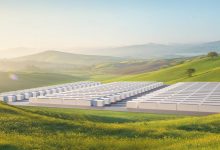California utility Pacific Gas and Electric (PG&E) has asked for regulatory approval for five separate energy storage projects totalling 423MW, or nearly 1.7GWh of storage capacity, in a first phase of commissioning system reliability resources required to come online by August 2021.
In a filing with the California Public Utilities Commission (CPUC), PG&E detailed the five projects, intended to further integrate the state’s renewable generation sources while ensuring future reliability of the electric system.
The five projects, the result of a competitive tender process, all feature lithium-ion battery energy storage systems (BESS), each with a four-hour discharge duration, and will be co-located with renewable energy plants or be built as part of new stand-alone energy storage projects.
Among the projects – detailed in the table below – the Coso Battery Storage plant would co-locate a 60MW/240MWh transmission-connected, stand‑alone lithium-ion battery with an existing geothermal project in Little Lake, California.
Another, the Vistra Energy MOSS100 Energy Storage Project by Dynegy Marketing and Trade, is a 100MW/400MWh expansion of the massive 300MW energy storage project under contract to PG&E at the same location, which is currently under development.
NextEera Energy Resources Development is also among the winners, with a 15-year agreement for a 63MW/252MWh lithium-ion battery co-located with an existing 110MW solar project built in 2016 in Blythe, California.
 As noted above, the five projects would fulfil more than half of the 716.9MW of system reliability resources PG&E was authorised to procure to come online between August 01, 2021 and August 01, 2023.
As noted above, the five projects would fulfil more than half of the 716.9MW of system reliability resources PG&E was authorised to procure to come online between August 01, 2021 and August 01, 2023.
The agreements for the projects are the result of a competitive request for offers (RFO) PG&E launched in February following a November 2019 CPUC decision that identified potential reliability issues beginning in 2021.
“PG&E is deeply committed to the California vision of a sustainable energy future,” the utility’s senior vice president of energy policy and procurement, Fong Wan, said in a statement on Monday.
“As we continue to integrate large amounts of intermittent renewable energy, we are now taking advantage of advancements in energy storage technology to ensure that customers continue to receive clean and reliable power from a flexible and dependable electric grid.”
Details of the PG&E-proposed BESS projects come less than one week after plans to install a 100MW/400MWh big battery to replace a natural gas peaker plant in southern California edged closer to realisation after the Tesla was awarded the EPC contract for the project.
Project developer Strata Solar said on Thursday last week the construction was now scheduled to commence in July 2020, making the project a likely contender for the world’s first grid-scaleTesla Megapack energy storage system.
Earlier this week, Australia-founded and London-based energy investment outfit Quinbrook Infrastructure Partners underscored just how big the US energy storage market is expected to be, by announcing the launch of a spin-off company, Primergy Solar, that will specialise in the development and operation of large-scale solar and battery projects across North America.
RenewEconomy and its sister sites One Step Off The Grid and The Driven will continue to publish throughout the Covid-19 crisis, posting good news about technology and project development, and holding government, regulators and business to account. But as the conference market evaporates, and some advertisers pull in their budgets, readers can help by making a voluntary donation here to help ensure we can continue to offer the service free of charge and to as wide an audience as possible. Thankyou for your support.










